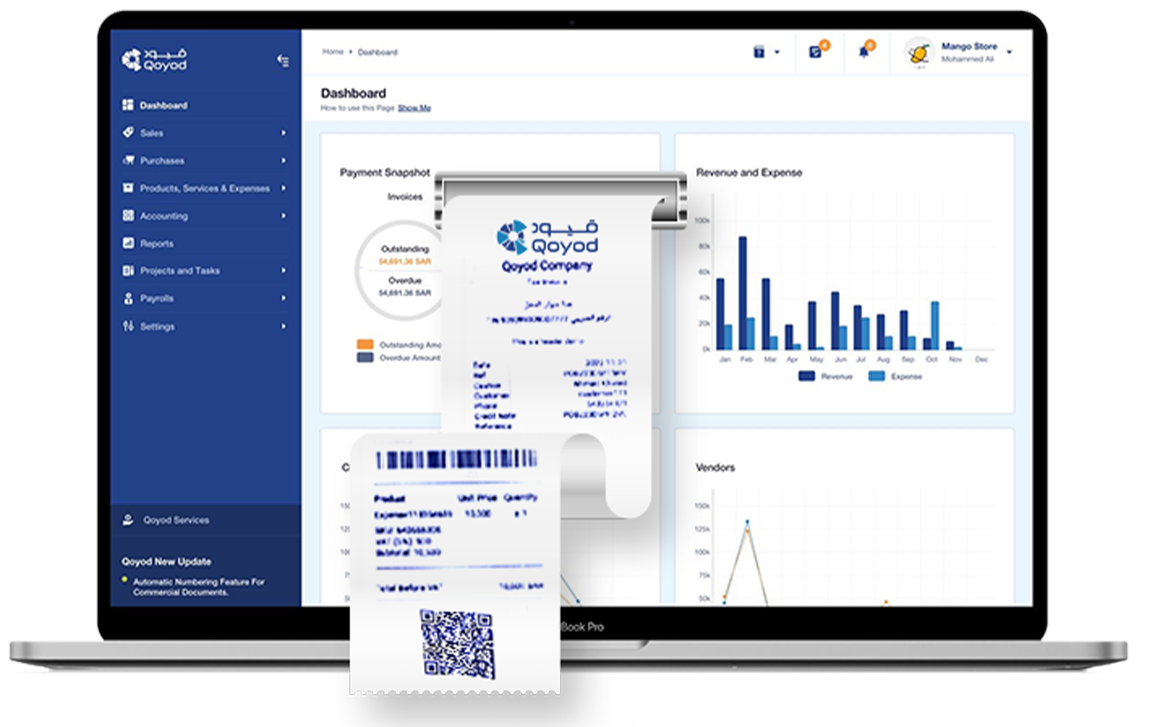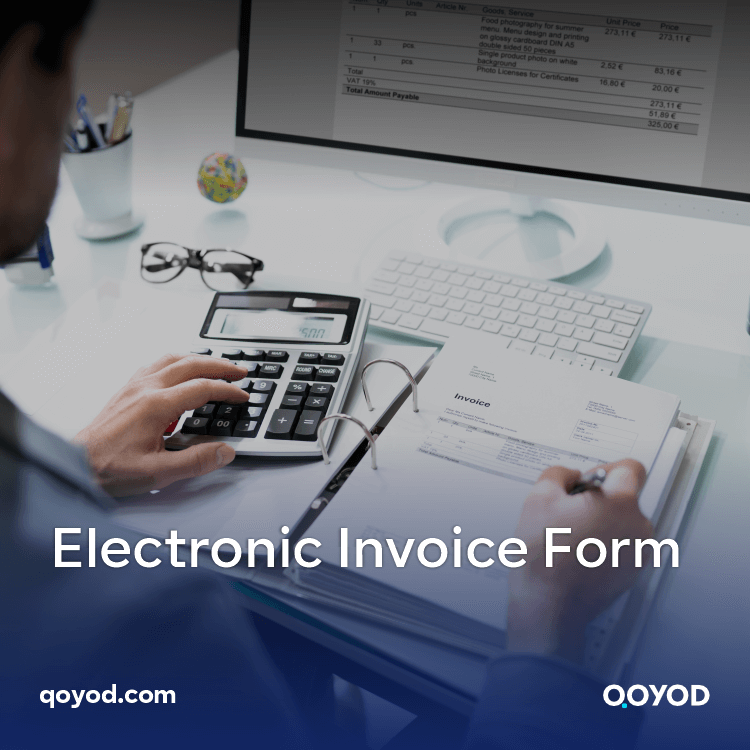In our time, we are witnessing major changes in the way business is conducted, with business processes being managed mainly electronically in many enterprises, and this digital shift has forced many enterprises to adopt electronic systems to manage their business and transactions, starting with internal and external communication and leading to the adoption of an electronic billing program for the creation and transmission of electronic invoices.
In this context, electronic invoicing software has become an essential part of digital enterprise systems. Due to the many benefits they offer, such as speed and ease in issuing invoices, eliminating potential human errors, reducing supplier inquiries, speeding up approvals, and saving costs and resources, these programs have become an urgent need for all organizations.
The concept of an electronic invoice
The electronic invoice is a legal and financial alternative to the paper invoice, which is delivered electronically with specific standardized coordination, and the transmission and reception systems can share and identify data as these systems are used for standardized coordination. Since electronic invoices contain invoice data in a structured format, they can be automatically imported into the enterprise’s system of credit accounts.
Some believe that the concept of an electronic invoice is limited to any invoice sent and received by electronic means, and while this is a requirement to consider the invoice as electronic, it must, in addition, be properly constructed and transferred from the seller’s system to the buyer’s system, so that the electronic invoice becomes an alternative with legal and financial characteristics similar to those of the paper invoice, and it is therefore preferable to use electronic invoice software to issue it.
Benefits of the e-invoice program
There is no doubt that saving electronic invoice software time, effort, and cost by abandoning paper invoices and associated manual procedures in your organization is one of its most important benefits, but the real benefit of electronic invoicing software lies in the level of integration that you can achieve not only with your business partners but between the electronic invoice software and your organization’s business systems as well.
The benefits of electronic invoicing programs are not limited to that, but these programs provide many benefits to institutions and individuals, some of which can be summarized as follows:
1. Increased efficiency of administrative processes
Electronic invoicing programs automate invoicing processes in a way that reduces errors associated with paper invoices. This helps to increase the efficiency of the enterprise’s administrative processes. Documents are issued, sent, received, and recorded promptly and automatically in electronic billing software. All transactions are integrated with both the internal management systems of the sender and the recipient.
2-Cost reduction
There is no doubt that the adoption of an electronic invoicing program significantly reduces the cost of issuing, sending, and receiving invoices. Studies have shown that electronic invoicing programs provide up to 90% of the cost of issuing and managing the same documents in paper form.
3-Time saving
Electronic invoicing software saves time by reducing response time, increasing efficiency and speed in the transmission and receipt of documents, and reducing errors in the issuance of documents almost holistically, resulting in a significant reduction in response and payment times, thus saving time.
4: Reducing human error
Electronic invoice software reduces the risk of invoice errors by digitizing invoice data and matching it with contracts, purchase orders, service entry papers, and cargo receipts. The electronic invoice can be automatically verified before it is transferred for payment when it is sent on a digital business network and programmed with relevant document data and working rules.
5: Ensuring the security of communications
Electronic invoicing software ensures security and confidentiality in its management of electronic invoices, including by managing the delivery of these documents through special networks such as VAN (Value Added Network) or through point-to-point protocols such as AS2.
6: Ensuring the integrity of the document
The electronic signatures of the sender and the recipient in the electronic invoice program guarantee the integrity of content and the authenticity of origin, as accuracy is increased when there is less need for manual data entry. Human error is the greatest cause of potential errors and duplicate payments. Electronic invoices also allow automatic reconciliation and validation against three types of documents: purchase orders, invoices, and shipping receipts.
7: Integration with management systems
Electronic invoices and other documents can be automated from data recorded in management systems, and electronic receipts allow the receipt of invoices to automate the validation and standardization process, thus providing for direct registration in the accounts management system without human interference.
8: The electronic bills are environmentally friendly.
The use of an electronic invoice is not only an excellent first step in the digital transformation journey of your institution but also an environmentally friendly step that preserves and reduces resource waste. It is important to ensure that the operations of your institution are efficient and capable of being developed to support future growth while eliminating any negative environmental impact by using less paper and ink.
How do electronic invoices differ from traditional ones?
Traditional invoices include the receipt of a paper invoice by mail, the details of which must be manually entered into the financial regulations of the organization, and a separate official must approve the payment of the invoice. Therefore, if the approval system is separate from the invoicing system, it may require manual entry of the data again, which may take a lot of time and effort.
A check or any other form of payment is written or printed and sent by mail to the seller. If the payment system is electronic and does not integrate with the invoice or approval systems, staff members are assigned to enter the data a third time. Finally, a paper copy of the invoice must be submitted for record.
This billing method is considered to be subject to human error and slowness at every step of the process, and these risks are not available in electronic invoices, which makes electronic billing software an attractive option for enterprises.
Advantages of the e-invoice program
Electronic invoicing programs simplify invoice management, and due to the ease of displaying digital information across systems compared to paper, electronic invoicing programs facilitate the following:
- Reduce costs and improve cash management as early payment discounts can be obtained.
- Manage complex services and billing more efficiently and effectively.
- Enhance compliance with contracts, company policies, and global e-invoicing regulations.
- Facilitate the management of cumbersome compliance tasks.
- Facilitate cooperation within the organization and between trading partners.
- Reduce the risk of overpayment or fraud.
- Improve suppliers’ cash flow through timely payment.
- Enable faster and more accurate invoice processing.
- Facilitate access to invoice status via the web.
Security and data privacy in electronic invoicing programs
One of the reasons for the fear of using an electronic invoice program may be the security and privacy of these programs, but do not worry, as electronic invoice programs are keen on the best practices for security and data privacy in electronic invoices.
Invoices can be sent more securely when using the e-invoice view and payment platform; this method does not send an invoice directly via an unsecured email; instead, a notification is sent via email, and then users can log in to the platform to view invoice data.
Risks of e-invoicing
Not sending e-invoicing software avoids some of the risks inherent in e-mail invoicing, and here are some of these risks:
- Receiving the electronic invoice from an incorrect person, or the e-mail bounces and does not arrive due to human error.
- Risk of interception or payment forwarding.
- Phishing attacks use false payment requests.
Electronic invoice software also provides security features such as two-factor authentication or a document access limit unless certain rules are met so that only authorized users can view and manage invoice information.

In conclusion…
The start of electronic billing and receipt can be an excellent first step in your company’s digital transition journey. When bills are digitized and transactions are done on a digital business network, a lot of human effort is provided, so staff can focus on strategic activities instead of manually entering billing data all day.
Using an electronic invoice program is a sure step in ensuring the efficiency of operations in your organization and their scalability to support future growth. As many people resort to using their mobile phones to complete all their transactions electronically, your use of an electronic billing program will undoubtedly ensure the future of your organization.
Qoyod Accounting System provides you with a multi-featured electronic invoice program in the Kingdom of Saudi Arabia, and you only need to activate the electronic invoice with just one click of a button from Qoyod Accounting Program to enjoy all the advantages of issuing electronic invoices that are compatible with the items set by the Zakat, Tax, and Customs Authority in the Kingdom.




